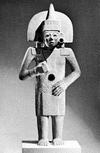- Quetzalcoatl
-
/ket sahl'koh aht"l/, n.the feathered serpent god of the Aztec and Toltec cultures.[ < Sp Quetzalcóatl < Nahuatl Quetzalcoatl, equiv. to quetzal(li) (see QUETZAL) + coatl snake]
* * *
Feathered Serpent, a major deity of ancient Mexico.Quetzalcóatl began as a god of vegetation in the Teotihuacán civilization. For the Toltecs he was the god of the morning and evening star. The Aztecs revered him as the patron of priests, the inventor of the calendar and of books, and the protector of goldsmiths and other craftsmen. He was also identified with the planet Venus and was a symbol of death and resurrection. One myth held that he was a white priest-king who sailed away on a raft made of snakes. The belief that he would someday return from the east led Montezuma II to regard Hernan Cortes as the fulfillment of the prophecy. Quetzalcó;atl, limestone figure of the Huastec culture, Mexico, AD 900–1250; in The ...By courtesy of The Brooklyn Museum, New York, Henry L. Batterman and Frank S. Benson Funds
Quetzalcó;atl, limestone figure of the Huastec culture, Mexico, AD 900–1250; in The ...By courtesy of The Brooklyn Museum, New York, Henry L. Batterman and Frank S. Benson Funds* * *
▪ Meso-American god(from Nahuatl quetzalli, “tail feather of the quetzal bird [Pharomachrus mocinno],” and coatl, “snake”), the Feathered Serpent, one of the major deities of the ancient Mexican pantheon. Representations of a feathered snake occur as early as the Teotihuacán civilization (3rd to 8th century AD) on the central plateau. At that time, Quetzalcóatl seems to have been conceived as a vegetation god—an earth and water deity closely associated with the rain god Tlaloc.With the immigration of Nahua-speaking tribes from the north, Quetzalcóatl's cult underwent drastic changes. The subsequent Toltec culture (9th through 12th centuries), centred at the city of Tula, emphasized war and human sacrifice linked with the worship of heavenly bodies. Quetzalcóatl became the god of the morning and evening star, and his temple was the centre of ceremonial life in Tula.In Aztec times (14th through 16th centuries) Quetzalcóatl was revered as the patron of priests, the inventor of the calendar and of books, and the protector of goldsmiths and other craftsmen; he was also identified with the planet Venus. As the morning and evening star, Quetzalcóatl was the symbol of death and resurrection. With his companion Xolotl, a dog-headed god, he was said to have descended to the underground hell of Mictlan to gather the bones of the ancient dead. Those bones he anointed with his own blood, giving birth to the men who inhabit the present universe.One important body of myths describes Quetzalcóatl as the priest-king of Tula, the capital of the Toltecs. He never offered human victims, only snakes, birds, and butterflies. But the god of the night sky, Tezcatlipoca, expelled him from Tula by performing feats of black magic. Quetzalcóatl wandered down to the coast of the “divine water” (the Atlantic Ocean) and then immolated himself on a pyre, emerging as the planet Venus. According to another version, he embarked upon a raft made of snakes and disappeared beyond the eastern horizon.The legend of the victory of Tezcatlipoca over the Feathered Serpent probably reflects historical fact. The first century of the Toltec civilization was dominated by the Teotihuacán culture, with its inspired ideals of priestly rule and peaceful behaviour. The pressure of the northern immigrants brought about a social and religious revolution, with a military ruling class seizing power from the priests. Quetzalcóatl's defeat symbolized the downfall of the Classic theocracy. His sea voyage to the east should probably be connected with the invasion of Yucatán by the Itzá, a tribe that showed strong Toltec features. Quetzalcóatl's calendar name was Ce Acatl (One Reed). The belief that he would return from the east in a One Reed year led the Aztec sovereign Montezuma II to regard the Spanish conqueror Hernán Cortés (Cortés, Hernán, marqués del Valle de Oaxaca) and his comrades as divine envoys, because 1519, the year in which they landed on the Mexican Gulf coast, was a One Reed year. (See also Aztec calendar.)In addition to his guise as a plumed serpent, Quetzalcóatl was often represented as a man with a beard; as Ehécatl, the wind god, he was shown with a mask with two protruding tubes (through which the wind blew) and a conical hat typical of the Huastec tribe of northeastern Mexico. The temple of Quetzalcóatl at Tenochtitlán, the Aztec capital, was a round building, a shape that fitted the god's personality as Ehécatl. Circular temples were believed to please Ehécatl because they offered no sharp obstacles to the wind. Round monuments occur particularly often in Huastec territory.Quetzalcóatl ruled over the days that bore the name ehécatl (“wind”) and over the 18th 13-day series of the ritual calendar. He was also the ninth of the 13 gods of the daytime hours. Although he was generally listed as one of the first-rank deities, no ceremonial month was dedicated to his cult.As the god of learning, of writing, and of books, Quetzalcóatl was particularly venerated in the calmecac, religious colleges annexed to the temples, in which the future priests and the sons of the nobility were educated. Outside of Tenochtitlán, the main centre of Quetzalcóatl's cult was Cholula, on the Puebla plateau.* * *
Universalium. 2010.
